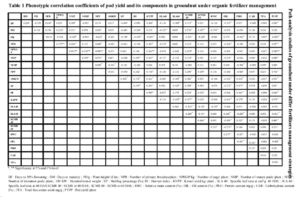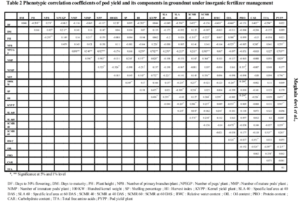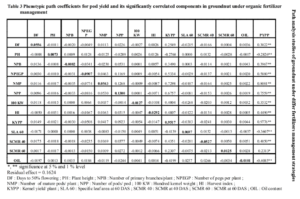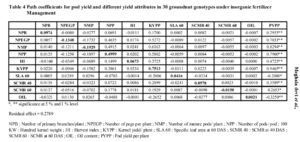CORRELATION AND PATH ANALYSIS STUDIES IN GROUNDNUT (Arachis hypogaea L.) UNDER ORGANICAND INORGANIC FERTILIZER MANAGEMENTS.
0 Views
G. MEGHALA DEVI*, M. SHANTHI PRIYA, M. REDDI SEKHAR AND P. LATHA
Department of Genetics and Plant Breeding, S.V. Agricultural college,ANGRAU, Tirupati- 517502, Chittoor District, Andhra Pradesh, India
ABSTRACT
Character association and path analysis studies were conducted in 30 genotypes of groundnut under organic and inorganic fertilizer managements. Significant positive association of pod yield per plant with number of primary branches per plant, number of pegs per plant, number of mature pods per plant, number of pods per plant, harvest index, kernel yield per plant, SCMR at 40 DAS, SCMR at 60 DAS and significant negative association of pod yield per plant with SLA at 60 DAS and oil content was observed under both fertilizer managements. Path analysis revealed that kernel yield per plant registered high positive direct effect on pod yield per plant under both fertilizer managements and number of pods per plant exhibited high positive direct effect only under inorganic fertilizer management. Hence selection for these traits would be effective for improvement of pod yield per plant under respective fertilizer managements.
KEYWORDS:
INTRODUCTION
Groundnut (Arachis hypogaea L.) is an important protein rich oil seed crop belonging to the family Fabaceae which ranks 6th in world oil seed crops and 13th in world food crops. It is a self-pollinated annual legume crop and a segmental allotetraploid (2n=40). Indiscriminate use of chemical fertilizers in conventional farming system is causing soil degradation and environmental pollution. Hence organic farming is the need of the hour to ensure safe food production and to keep the land in healthy condition.
In organic farming the major constraint is lack of suitable varieties specifically bred for organic farming. The varietal trial under organic farming conditions show that the modern varieties are not in all cases the best for organic agriculture. Hence organically-bred plant varieties are needed to develop both the potential of organic agriculture and its integrity. (Martin 2002).
In India, groundnut is mainly grown under rainfed conditions where the crop is frequently exposed to drought. Hence, the physiological parameters like specific leaf area
(SLA), SPAD chlorophyll meter reading (SCMR) and relative water content will be helpful in selection of genotypes having high water use efficiency.
Yield is a complex character influenced by a number of other yield contributing characters. Hence there is a need to understand the relationship between yield and its component characters to make best use of these characters in selection. In view of this, correlation analysis was conducted for pod yield and its component characters. These traits may have either direct or indirect relationship with the pod yield. Hence path coefficient analysis was carried out to separate direct and indirect effects which gives more realistic relationship of characters and help in effective selection.
MATERIALAND METHODS
The experiment was carried out during Kharif, 2017 at dryland farm of S. V. Agricultural College, Tirupati. Experimental material consisted of 30 groundnut genotypes and was sown under two separate trials i.e., organic and inorganic fertilizer managements using randomized block design with three replications. Each genotype was sown in 2 rows of 2.5 m length with 30 cm × 10 cm spacing.
Under organic fertilizer management, at the time of field preparation FYM @ 5 t /acre was applied and seed treatment was done with Panchagavya. Jeevamruth was applied at 15 days interval. Bramhastram was sprayed against sucking pests. Under inorganic fertilizer management, FYM @ 5 t /acre was applied at the time of field preparation and recommended dosage of fertilizers
@ of 20 kg N, 40 kg P2O5 and 50 kg K2O per hectare in the form of urea, single super phosphate and murate of potash were broadcasted before sowing. Other cultural practices were common for both fertilizer managements.
The data was recorded for twenty two characters like viz., days to 50% flowering, days to maturity, plant height, number of primary branches per plant, number of pegs per plant, number of mature pods per plant, number of immature pods per plant, total number of pods per plant, 100-kernel weight, shelling percent, harvest index, kernel yield per plant, SLA at 40 DAS, SLA at 60 DAS, SCMR at 40 DAS, SCMR at 60 DAS, relative water content, oil content, protein content, carbohydrate content, total free amino acids and pod yield
per plant.
RESULTS AND DISCUSSION
Analysis of variance revealed highly significant differences for all the characters under both the fertilizer managements indicating the presence of sufficient variability in the material. The phenotypic correlation coefficients for twenty two characters under organic and inorganic fertilizer managements was presented in Tables 1 and 2.
Under organic fertilizer management pod yield per plant was significantly and positively correlated with kernel yield per plant (r = 0.978) followed by number of mature pods per plant (r = 0.808), number of pods per plant (r = 0.756), number of pegs per plant (r = 0.588), harvest index (r = 0.449), SCMR at 40 DAS (r = 0.405), number of primary branches per plant (r = 0.397), hun-dred kernel weight (r = 0.353), days to 50% flowering (r
= 0.302) and SCMR at 60 DAS (r = 0.231) indicating that selection for high kernel yield per plant, more number of mature pods per plant, number of primary branches per plant, high harvest index, hundred kernel weight and high SCMR at 40 DAS, SCMR at 60 DAS will lead to in-crease in pod yield per plant. It also showed significant negative correlation with SLA at 60 DAS and oil content.
Under inorganic fertilizer management highly sig-nificant positive association was observed for pod yield per plant with kernel yield per plant (r = 0.947) followed by number of mature pods per plant (r = 0.829), number of pods per plant (r = 0.796), number of pegs per plant (r
= 0.703), harvest index (r = 0.472), SCMR at 40 DAS (r
= 0.359), number of primary branches (r = 0.295) and SCMR at 60 DAS (r = 0.265) indicating that selection for above characters will lead to improvement in pod yield per plant. It also exhibited significant negative correlation with SLA at 60 DAS (r = -0.208) and oil content (r = – 0.325).
Pod yield per plant showed significant positive correlation with SCMR at 40 DAS, SCMR at 60 DAS and significant negative correlation with SLA at 60 DAS under both organic and inorganic fertilizer managements indicating that selection for high SCMR and low SLA will lead to increase in pod yield per plant along with water use efficiency. Oil content showed significant negative association with pod yield per plant under both organic and inorganic fertilizer managements. Hence, selection
programme might be formulated by repeated intermating to break the negative correlation between oil content and pod yield plant for simultaneous improvement of these characters.
Similar kind of results viz., significant positive correlation of pod yield per plant with number of mature pods per plant and kernel yield per plant was reported by Shashikumara et al. (2015) and Mahesh et al. (2018). Significant positive correlation for kernel yield per plant with pod yield per plant was also recorded by Jayalakshmi and Reddy (2003), Giri et al. (2009), Rao et al. (2014), Surbhi et al. (2016) and Mukesh et al. (2017). Significant positive correlation of harvest index with pod yield per plant was reported by Jayalakshmi and Reddy (2003), Shahshikumara et al. (2015). Trivikrama et al. (2017) reported significant positive correlation of number of pegs
per plant and number of pods per plant with pod yield per plant. Rao et al. (2014) and Shashikumara et al. (2015)
also observed significant positive correlation of pod yield with number of pods per plant. Significant positive correlation with of pod yield per plant with SCMR was observed by Shashikumara et al. (2015). Significant negative correlation for oil content with pod yield was also reported by Tulsiram et al. (2017) and for SLA was reported by Shashikumara et al. (2015).
Path coefficient analysis was conducted with pod yield as dependent variable and significantly correlated traits as independent variables under both organic and inorganic fertilizer managements and the results were presented in Tables 4 and 5.
Under organic fertilizer management, kernel yield per plant showed highest positive direct effect (0.9517) on pod yield per plant whereas other characters days to 50% flowering (0.0566), plant height (0.0073), number of mature pods (0.0543), number of pods per plant (0.1300), SLA at 60 DAS (0.0697), SCMR at 60 DAS (0.0125) exhibited negligible positive direct effects on pod yield per plant. Similar kind of high positive direct effect of kernel yield per plant on pod yield per plant was observed by Aparna et al. (2017).
The traits, number of primary branches per plant (0.3490), number of pegs per plant (0.5334), number of mature pods per plant (0.7298), number of pods per plant (0.6757), hundred kernel weight (0.4004), harvest index (0.4807), SCMR at 40 DAS (0.4351) exhibited high posi-tive indirect effects through kernel yield per plant on pod yield per plant.
Under inorganic fertilizer management, kernel yield per plant (0.7513) and number of pods per plant (0.4999) showed high positive direct effects on pod yield per plant whereas other traits like number of primary branches per plant (0.0974), harvest index (0.0673), SLA at 60 DAS (0.0416), SCMR at 40 DAS (0.0578) and oil content (0.0021) exhibited negligible positive direct effects on pod yield per plant. High positive direct effects for kernel yield per plant was also reported by Giri et al. (2009) and Tulsiram et al. (2017).
The traits, number of pegs per plant (0.5272), number of mature pods per plant (0.6163), number of pods per plant (0.5802), harvest index (0.3725) and SCMR at 40 DAS (0.2899) showed moderate to high indirect effects through kernel yield per plant on pod yield per plant whereas the traits number of pegs per plant (0.4635), number of mature pods per plant (0.4915), kernel yield per plant (0.3861) showed high indirect effects through number of pods per plant.
These results specified that by keeping the other traits constant selection for kernel yield per plant under organic management and for kernel yield per plant and number of pods per plant under inorganic fertilizer management will result in an increased pod yield per plant under respective environments.
REFERENCES
- Aparna, P., Shanthi, M. P., Reddy, D. M and Latha, P. 2017. Correlation and path coefficient analysis for pod yield and its components in groundnut (Arachis hypogaea L.) under organic fertilizer managements. Bulletin of Environment, Pharmacology and Life Sciences. 6(3) : 258-261.
- Giri, R. R. 2009. Genetic variability, character association and path analysis for yield, its component traits and late leaf spot, Phaeoisariopsis personata (Berk and curt), in groundnut. International Journal of Plant Sciences. 4(2) : 551-555
- Jayalakshmi, V and Reddy, G.L. 2003. Genetic variability and correlation studies in groundnut hybrids. Agricultural Science Digest. 23 (4): 247 – 250.
- Mahesh, R. H., Hasan, K., Temburne, B. V., Janila, P and Amaregouda, A. 2018. Genetic variability, correlation and path analysis studies for yield and yield attributes in groundnut (Arachis hypogaea L.). Journal of Pharmacognosy and Phytochemistry. 7(1): 870-874
- Martin, S. W. 2002. Organic plant breeding. UK Organic Research 2002. Proceedings of the COR Conference, March 2002, 303-305.
- Mukesh, B and Lal, G. M. 2017. Estimation of genetic variability, correlation and path analysis in groundnut (Arachis hypogaea L.) germplasm. Chemical Science Reviews and Letters. 6(22) :
- 1107-1112.
- Rao, V.T., Venkanna, V., Bhadru, D and Bharathi, D. 2014. Studies on variability, character association and path analysis on groundnut (Arachis hypogaea L.). International Journal of Pure and Applied Bioscience. 2 (2): 194-197.
- Shashikumara, P., Sanjeev, B. G and Venkataravana, P. 2015. Studies on correlation and path analysis for traits related to water use efficiency and pod yield and its components in groundnut (Arachis hypogaea L.). The Bioscan. 10(4) : 2155-2158.
- Surbhi, J., Singh, P. B and Sharma, P. P. 2016. Correlation and path analysis in groundnut (Arachis hypogaea L.). International Journal of Current Research. 8(8) : 35811-35813.
- Trivikrama, A. R., Reddi, M. S., Vijayabharathi, A., Lakshmipathy, T., Reddy, G. L and Jayalakshmi, V. 2017. Correlation and path analysis of kernel yield and its components in groundnut (Arachis hypogaea L.). International Journal of Current Microbiology and Applied Sciences. 6(12): 10-16
- Tulsiram, D., Hemalatha, S., Ramesh, K and Ram, K. 2017. Correlation and path analysis for yield and its contributing traits in groundnut (Arachis Hypogaea. L.). International Journal of Agriculture Sciences. 9(10) : 3997-3999.




- Bio-Formulations for Plant Growth-Promoting Streptomyces SP.
- Brand Preference of Farmers for Maize Seed
- Issues That Consumer Experience Towards Online Food Delivery (Ofd) Services in Tirupati City
- Influence of High Density Planting on Yield Parameters of Super Early and Mid Early Varieties of Redgram (Cajanus Cajan (L.) Millsp.)
- Influence of Iron, Zinc and Supplemental N P K on Yield and Yield Attributes of Dry Direct Sown Rice
- Effect of Soil and Foliar Application of Nutrients on the Performance of Bold Seeded Groundnut (Arachis Hypogaea L.)

